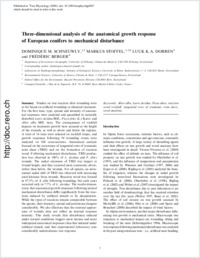Three-dimensional analysis of the anatomical growth response of European conifers to mechanical disturbance
- Schneuwly, Dominique M. Department of Geosciences, Geography, University of Fribourg, Switzerland
- Stoffel, Markus Department of Geosciences, Geography, University of Fribourg, Switzerland - Laboratory of Dendrogeomorphology, Institute of Geological Sciences, University of Berne, Switzerland - Environmental Sciences, University of Geneva, Switzerland
- Dorren, Luuk K.A. Federal Office for the Environment, Hazard Prevention Division, Bern, Switzerland
- Berger, Frédéric Cemagref Grenoble, Saint Martin d’Hères France
-
20.08.2009
Published in:
- Tree Physiology. - 2009, vol. 29, no. 10, p. 1247-1257
Abies alba
Larix decidua
Picea abies
reaction wood rockfall
tangential rows of traumatic resin ducts
wood anatomy
English
Studies on tree reaction after wounding were so far based on artificial wounding or chemical treatment. For the first time, type, spread and intensity of anatomical responses were analyzed and quantified in naturally disturbed Larix decidua Mill., Picea abies (L.) Karst. and Abies alba Mill. trees. The consequences of rockfall impacts on increment growth were assessed at the height of the wounds, as well as above and below the injuries. A total of 16 trees were selected on rockfall slopes, and growth responses following 54 wounding events were analyzed on 820 cross-sections. Anatomical analysis focused on the occurrence of tangential rows of traumatic resin ducts (TRD) and on the formation of reaction wood. Following mechanical disturbance, TRD production was observed in 100% of L. decidua and P. abies wounds. The radial extension of TRD was largest at wound height, and they occurred more commonly above, rather than below, the wounds. For all species, an intra-annual radial shift of TRD was observed with increasing axial distance from wounds. Reaction wood was formed in 87.5% of A. alba following wounding, but such cases occurred only in 7.7% of L. decidua. The results demonstrate that anatomical growth responses following natural mechanical disturbance differ significantly from the reactions induced by artificial stimuli or by decapitation. While the types of reactions remain comparable between the species, their intensity, spread and persistence disagree considerably. We also illustrate that the external appearance of wounds does not reflect an internal response intensity. This study reveals that disturbance induced under natural conditions triggers more intense and more widespread anatomical responses than that induced under artificial stimuli, and that experimental laboratory tests considerably underestimate tree response.
- Faculty
- Faculté des sciences et de médecine
- Department
- Département de Géosciences
- Language
-
- English
- Classification
- Biological sciences
- License
- License undefined
- Identifiers
-
- RERO DOC 12630
- DOI 10.1093/treephys/tpp056
- Persistent URL
- https://folia.unifr.ch/unifr/documents/301247
Statistics
Document views: 100
File downloads:
- schneuwly_tda.pdf: 177
